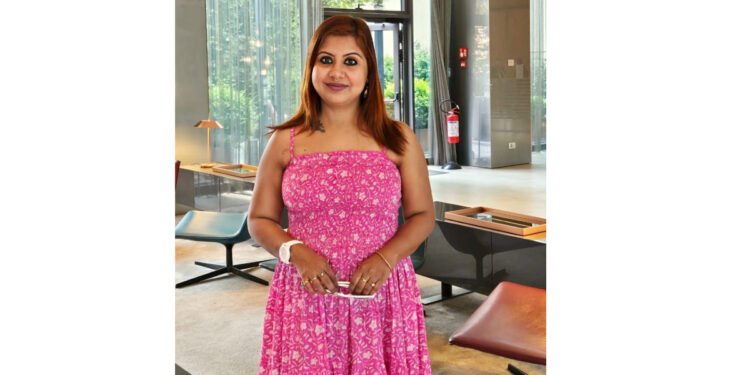by Author Naynaa Chakravorrty
Three Women. Three Secrets. One Deadly Truth.
In THE OTHER WOMAN, Author Naynaa Chakravorrty delivers a gripping romantic thriller where love, lies, and fate collide in the most unexpected ways.
When Varsha and Varun’s passionate love story is shattered by the shocking murder of Varun’s ex-fiancée, Lipika, their world spirals into chaos. As suspicion closes in, the couple is forced to flee—racing against time to uncover long-buried truths, evade the law, and protect their bond from unraveling beneath the crushing weight of secrets.
Set against the atmospheric backdrops of Banaras and Jaipur,The Other Woman is an emotionally charged tale of love tested by destiny, shadowed by deception, and haunted by a single, lingering question: Who is the other woman?
Who Should Read This Book?
- Fans of intense romance wrapped in mystery and suspense
- Readers who crave emotionally layered characters and unpredictable twists
- Lovers of Indian fiction enriched with culture, atmosphere, and depth
- Anyone fascinated by fate, secrets, and the high cost of truth
Author Q&A :
1. What sparked the idea for this book, and what was the inspiration behind its story?
It all began with a casual discussion on prophecy and future readings. The idea of a fate sealed by words spoken long ago fascinated me. What if a single prediction could shape lives? That thought stayed with me. And when my daughter nudged me to try something beyond my usual genre, I knew it was time to dive into something darker, deeper – a romance thriller that plays with destiny, deception, and desire.
2. Can you walk us through your writing habits or rituals? How do you get into the creative mindset?
My writing process is more emotional than structured. I usually begin late at night, with music playing softly and a mug of coffee by my side. There’s something about quiet hours and dim lights that stirs the storyteller in me. Often, I start with a scene that haunts me, not the beginning. And from there, the rest unfolds. I don’t rush – my characters need time to breathe, and so do I.
3. Your characters feel so vivid and real—are they inspired by actual people, or entirely fictional creations?
They are mostly drawn from imagination but infused with shades of people I’ve observed or interacted with. Varsha, for instance, embodies grace under pressure – a quality I deeply admire. Varun is how I imagine a good man in today’s complex world – gentle yet strong. While none of the characters are directly based on real people, their emotions, dilemmas, and decisions reflect very real human experiences.
4. Themes like secrecy, crime, and fate are central to your novel. What drew you to explore these, and what do you hope readers take away from them?
More than just trust or betrayal, I wanted to explore the chilling weight of secrets – how they shape people, ruin relationships, or unexpectedly save them. The idea that love, when true, can survive even the darkest revelations was central to my heart. I hope readers walk away believing in the redemptive power of love and the quiet courage of those who stand by truth, no matter what.
5. The setting in your novel is rich and evocative. How did you craft such immersive environments, and were any real-world places or events an influence?
Yes, the settings are very much rooted in places that are real and dear to me – Banaras and Jaipur in particular. These cities hold layers of history, culture, and colour. I chose places where emotions naturally linger in the air. My idea was to set the story in places where most Indians have either been to or long to visit, and then gently layer the plot over those familiar backdrops.
6. How do you strike a balance between being original and meeting the expectations of the genre? Were there specific challenges in doing so?
Absolutely, it’s always a dance between staying true to the genre and telling a story only I can tell. I embraced familiar tropes like love triangles and suspense, but tried to place them in emotionally textured situations. The twist, for me, was in the characters’ emotional journeys, the subtle power dynamics, and the looming prophecy that adds an almost mythical tension to a modern story.
7. The story maintains a gripping pace from beginning to end. What’s your strategy for sustaining narrative tension and emotional momentum?
For me, pacing is all about rhythm. I alternate between high-intensity scenes and slower, more reflective moments to give readers space to feel. The tension comes not just from action or mystery, but from emotional stakes. Every time a character makes a choice, it must cost them something. That keeps the pages turning – not just what happens next, but why it happens.
8. With changing reader preferences and digital media on the rise, how do you see traditional storytelling evolving—and how do you keep your work relevant?
I believe traditional storytelling – rich in emotion, character, and layered plots – will always have a place. But we do need to be more mindful of the pace and accessibility. Readers today want stories that feel intimate yet gripping. I try to write in a language that feels both lyrical and relatable, and I stay connected with my readers through social media, where conversations help me understand what truly resonates with them.
Secrets, lies, and love await. Get your copy of THE OTHER WOMAN on Amazon today!

















